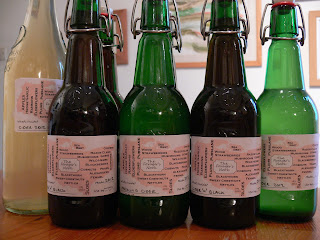The last of Sue's apple harvest (best part of 150lb's over the season) freshly juiced and made into Cider.
Someone on twitter asked about how many apples for how much juice for how much cider.
I get about 1 x 4.5Litre demi-john out of about 20-25lb of apples. you need to only fill the demi-john's 4/5ths full for the initial ferment (otherwise the rising cloud of yeasty bubbles will breach the airlock and cover your carpet with sticky stinky cider and yeast! - so for each 20-25lb batch, store the final litre of juice in a plastic bottle for a week until the initial ferment has settled, then add this, skimming off any of the scum that rises out of the demi-john when you top it up with the held-back juice.
Full recipe and instructions:-
1)Juice! - we use a Dualit juicer which takes about 20 minutes to juice 20lb of apples. having to stop every 5lb or so to clear the hood of debris and empty the bucket.
we don't use the silly little jug that comes with it that takes the juice of 3 apples...we direct the spout out into a 3litre steel pan to can carry on juicing longer.
the juice is then strained through a fine sieve into a big 25litre pan to clear the bulk of the sediment, etc.
2)"sterilise" to kill off natural yeasts.
There are 3 chains of thought....I've tried all three, and get the most consistent results this way.
Chain A) don't do anything with it...just demi-john it, lob in some extra yeast, and "see what happens". you will definitely get cider...you just might get a bit hit or miss as to the quality of the natural yeasts you encounter, and increases the likelyhood of a bacteria incidence in the brew too which will acetify it and make it turn to vinegar whilst it's maturing.
Chain B) use a chemical "campden tablet" - which is essentially sulphur dioxide - to kill bacteria and the natural yeats. before then adding your own yeast. I don't really like this, I think it alters the taste.
Chain C) (the one we use) - I quickly bring the apple juice up to 70 degrees to kill off all the natural yeast, and any bacteria, then quickly cool the pan in a sink of cold water, back down to 37 degrees.
This way, you have a sterile juice, you can control the brewing of, and it's also now at the perfect temp to begin fermenting.
3)demi-john and ferment
once sterile and ready to demi-john. we add yeast nutrient and pectolase (to dissolve out the pectin which can cause cloudy cider), then add some juice, then add the sachet of wine yeast, then top up with juice. top up to 4/5th's and add an airlock.
keep in a steady temp place (spare room, etc) and leave to ferment.
should take about 1 week before the initial brew finishes and settles. you can then top it up to 7/8th's (leave a little breathing room) and re-seal. leave it for another couple of weeks to re-ferment and settle.
at this point you have two choices...you can leave it in the demi-john to mature, or bottle it and leave it to mature in the bottles. we use the latter method.
4)Bottle it
make sure you heat sterilise the syphon and bottles well before use, syphon the cider out into the bottles.
if you want "flat" cider, any bottles will do. if you want naturally sparkling cider, then use "grolsch" type bottles (i.e. sprung loaded, pressurisable ones) and before you add the cider, add either a good table spoon of sugar (to reactivate the yeast and create sealed CO2 which dissolves in th cider creating sparkling cider), or even add a shot of your favourite fruit cordial...we use blackberry cordial - to make perfect pre-mixed sparkling fruit flavoured ciders.
seal these and leave to re-ferment in a cool place - I reckon given them at least another month to mature. chill well, open carefully!
depending on the yeast you used, you should get between 8% and 14% ABV - we get about 12% so if it's left to mature and clear for a few months it taste more like champagne than it does cider!













